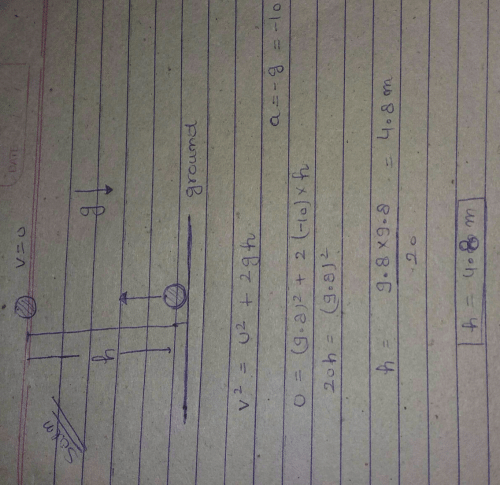Class 11 Exam > Class 11 Questions > A boy throws ball upward with velocity 9.8 me...
Start Learning for Free
A boy throws ball upward with velocity 9.8 metre per second how high does it goes in the air?
Most Upvoted Answer
A boy throws ball upward with velocity 9.8 metre per second how high d...
Calculating the Maximum Height of a Ball Thrown Upward
When a ball is thrown upward, its initial velocity is positive and its acceleration due to gravity is negative. The acceleration due to gravity is a constant value of -9.8 m/s², and it causes the ball to slow down as it moves upward until it reaches its maximum height and begins to fall back down to the ground. Using the principles of kinematics, we can calculate the maximum height that the ball reaches.
Step 1: Determine the Initial Velocity of the Ball
The initial velocity of the ball is given as 9.8 m/s. Since the ball is thrown upward, we take the initial velocity as positive.
Step 2: Determine the Time it Takes for the Ball to Reach its Maximum Height
The time it takes for the ball to reach its maximum height can be calculated using the following kinematic equation:
vf = vi + at
where:
- vf = final velocity (0 m/s at maximum height)
- vi = initial velocity (9.8 m/s upward)
- a = acceleration due to gravity (-9.8 m/s²)
- t = time
Solving for t, we get:
t = (vf - vi) / a
Since the final velocity is zero at maximum height, we can simplify the equation to:
t = -vi / a
Substituting the values, we get:
t = -9.8 m/s / -9.8 m/s²
t = 1 second
Step 3: Calculate the Maximum Height of the Ball
The maximum height that the ball reaches can be calculated using the following kinematic equation:
Δy = vi * t + 1/2 * a * t²
where:
- Δy = change in height (maximum height - initial height)
- vi = initial velocity (9.8 m/s upward)
- a = acceleration due to gravity (-9.8 m/s²)
- t = time (1 second)
Substituting the values, we get:
Δy = 9.8 m/s * 1 second + 1/2 * -9.8 m/s² * (1 second)²
Δy = 4.9 meters
Step 4: Interpret the Result
The maximum height that the ball reaches is 4.9 meters. This means that the ball travels 4.9 meters upward from its initial height before it begins to fall back down to the ground. It also takes 1 second to reach this maximum height.
Community Answer
A boy throws ball upward with velocity 9.8 metre per second how high d...


|
Explore Courses for Class 11 exam
|

|
Similar Class 11 Doubts
A boy throws ball upward with velocity 9.8 metre per second how high does it goes in the air?
Question Description
A boy throws ball upward with velocity 9.8 metre per second how high does it goes in the air? for Class 11 2025 is part of Class 11 preparation. The Question and answers have been prepared according to the Class 11 exam syllabus. Information about A boy throws ball upward with velocity 9.8 metre per second how high does it goes in the air? covers all topics & solutions for Class 11 2025 Exam. Find important definitions, questions, meanings, examples, exercises and tests below for A boy throws ball upward with velocity 9.8 metre per second how high does it goes in the air?.
A boy throws ball upward with velocity 9.8 metre per second how high does it goes in the air? for Class 11 2025 is part of Class 11 preparation. The Question and answers have been prepared according to the Class 11 exam syllabus. Information about A boy throws ball upward with velocity 9.8 metre per second how high does it goes in the air? covers all topics & solutions for Class 11 2025 Exam. Find important definitions, questions, meanings, examples, exercises and tests below for A boy throws ball upward with velocity 9.8 metre per second how high does it goes in the air?.
Solutions for A boy throws ball upward with velocity 9.8 metre per second how high does it goes in the air? in English & in Hindi are available as part of our courses for Class 11.
Download more important topics, notes, lectures and mock test series for Class 11 Exam by signing up for free.
Here you can find the meaning of A boy throws ball upward with velocity 9.8 metre per second how high does it goes in the air? defined & explained in the simplest way possible. Besides giving the explanation of
A boy throws ball upward with velocity 9.8 metre per second how high does it goes in the air?, a detailed solution for A boy throws ball upward with velocity 9.8 metre per second how high does it goes in the air? has been provided alongside types of A boy throws ball upward with velocity 9.8 metre per second how high does it goes in the air? theory, EduRev gives you an
ample number of questions to practice A boy throws ball upward with velocity 9.8 metre per second how high does it goes in the air? tests, examples and also practice Class 11 tests.

|
Explore Courses for Class 11 exam
|

|
Signup for Free!
Signup to see your scores go up within 7 days! Learn & Practice with 1000+ FREE Notes, Videos & Tests.
























